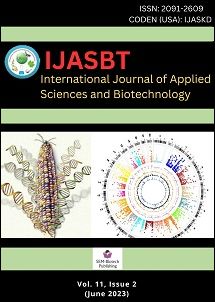A Prospect for Genome Wide Association Studies in Crops
DOI:
https://doi.org/10.3126/ijasbt.v11i2.56114Keywords:
Genome Wide Association Studies, Linkage Disequillibrium, Milestones, designs, LimitationsAbstract
Genome-wide association studies (GWAS) test hundreds of thousands of genetic variants across many genomes to find those statistically associated with a specific trait or disease. A Comprehensive review of studies on biotic resistance, abiotic tolerance, yield-associated characteristics, and metabolic composition is provided. Genome-wide SNP maps have characterized population structure concerning the geographic origin and morphological type and identified patterns of ancient crop diffusion to diverse agroclimatic regions. To better understand the genomic patterns of crop diversification, nucleotide diversity variation, linkage disequilibrium, and recombination rates across the genome are quantified. Results from GWAS can be used for a range of applications. The GWAS approach has proven highly suitable for identifying common SNP-based variants with moderate to significant effects on phenotype. However, the genetic factors underlying some of these associations have been characterized. The vast majority remain unexplained. The development of next-generation sequencing and bioinformatics tools has dramatically improved and is currently being implemented to decipher the genetic diversity of targeted traits. The significant drawbacks are the need for large population size, the cost of preparing DNA samples, and less knowledge about the risk of the quality. To overcome this drawback, researchers have upgraded the statistical approaches, proper imputation of genotypes, and advanced approaches such as nested association mapping and candidate gene association mapping. The primary benefit is one-time genotyping and repeated phenotyping in different environmental conditions.
Int. J. Appl. Sci. Biotechnol. Vol 11(2): 54-59.
Downloads
Downloads
Published
How to Cite
Issue
Section
License
Copyright (c) 2023 International Journal of Applied Sciences and Biotechnology

This work is licensed under a Creative Commons Attribution-NonCommercial 4.0 International License.




